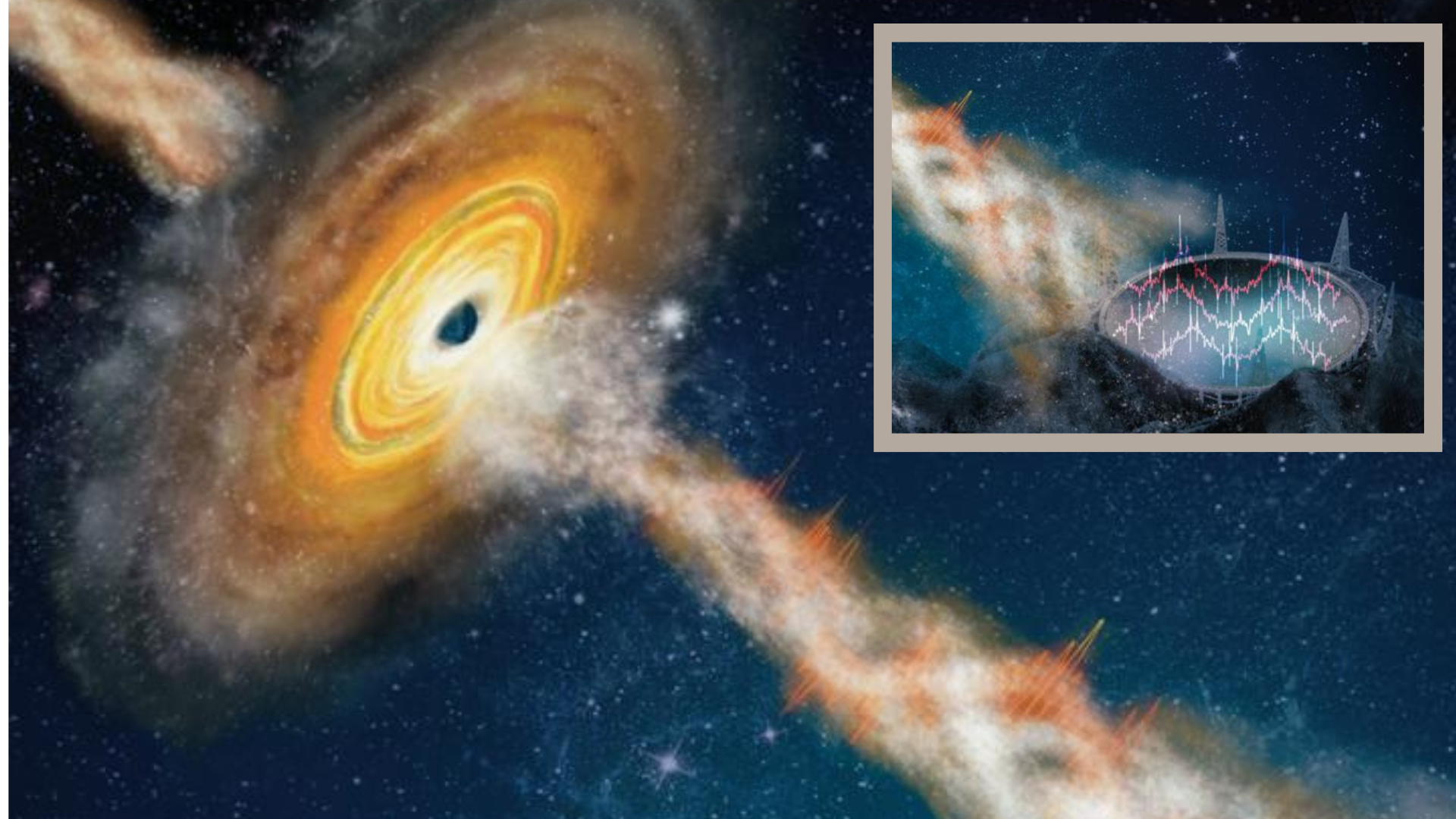Black hole jet surprises scientists with 'peculiar' radio signal
Superfast changes to the intensity of a jet blasting out from a small black hole have been detected for the first time.

Astronomers have spotted mysterious changes in a jet of highly magnetic plasma blasted out by a small black hole that is gorging on gas and dust.
The feature takes the form of periodic changes in the jet occurring within a fraction of a second that have been detected by the Five-hundred-meter Aperture Spherical radio Telescope (FAST) in China.
Astronomers know that the strange blinking object, called GRS 1915+105, consists of a regular star orbiting a stellar black hole, a black hole that was born after a massive star had died. As the star orbits the black hole, some of its material gets sucked into the cosmic monster, which fails to swallow all of the material and instead accelerates some of it into the jet that appears to squirt from its poles.
The team behind the observation thinks that the measured changes in the jet's energy could be due to the fact that the black hole's rotation isn't aligned with its accretion disk, the disk of orbiting matter it is feasting on. That could be causing the jet to wobble almost like a cosmic spinning top. When the jet points away, its energy drops. A fraction of a second later, it returns to normal when the system rotates back.
Related: A supermassive black hole is spitting a high-energy jet toward Earth
"The peculiar signal has a rough period of 0.2 seconds, or a frequency of about 5 Hertz," Wei Wang, a professor of astrophysics at Wuhan University in China and the lead author of the research, said in a statement. "Such a signal does not always exist and only shows up under special physical conditions. Our team was lucky enough to catch the signal twice — in January 2021 and June 2022, respectively."
GRS 1915+105 is what researchers call a microquasar, a star-scale version of a quasar. Quasars are extremely bright galactic hearts that harbor supermassive black holes that are millions or even billions of times more massive than the sun.
Get the Space.com Newsletter
Breaking space news, the latest updates on rocket launches, skywatching events and more!
These cosmic titans draw in surrounding matter with the force of their enormous gravity. Some of this matter falls past the black hole's event horizon, the point of no return from beyond which not even light can escape . Some material, however, escapes this fate and instead gets channeled toward the black hole's poles, emanating into space in the form of the super-energetic jets. This is also happening in microquasars, albeit on a much smaller scale.
Officially called quasi-periodic oscillations (QPO), changes seen in GRS 1915+105, have never been seen in radio waves from such a black hole before. QPOs are useful for understanding the physics of black holes and their surrounding systems, so this observation of this changing microquasar, located around 28,000 light-years from Earth in the direction of the constellation Aquila, could shed light on the feeding habits of smaller black holes.
This QPO, seen in radio waves, could be the first evidence of changes in jets of this type, but what exactly is causing these oscillations remains a mystery.
"In accreting black hole systems, X-rays usually probe the accretion disk around the black hole while radio emission usually probes the jet launched from the disk and the black hole," Bing Zhang, an astronomer at the University of Nevada and co-author of the researcher, said in the statement. "The detailed mechanism to induce temporal modulation in a relativistic jet is not identified, but one plausible mechanism would be that the jet is underlying precession, which means the jet direction is regularly pointing towards different directions and returns to the original direction once every about 0.2 seconds."
This effect may be caused by a misalignment between the spin axis of the black hole and the disk of hot and bright gas and dust around it. This would arise as a result of the fact that as the stellar mass black hole spins, it drags the very fabric of spacetime around with it — an effect called the Lense–Thirring of just frame-dragging.
"Other possibilities exist, though, and continued observations of this and other galactic microquasars will bring more clues to understand these mysterious QPO signals," said Zhang.
The team’s research was published in the July 26 edition of the journal Nature.
Join our Space Forums to keep talking space on the latest missions, night sky and more! And if you have a news tip, correction or comment, let us know at: community@space.com.

Robert Lea is a science journalist in the U.K. whose articles have been published in Physics World, New Scientist, Astronomy Magazine, All About Space, Newsweek and ZME Science. He also writes about science communication for Elsevier and the European Journal of Physics. Rob holds a bachelor of science degree in physics and astronomy from the U.K.’s Open University. Follow him on Twitter @sciencef1rst.
-
ARTGLICK While the surmised wobble is by far the most likely explanation for the varying signal, it occurs to me that using such an emanation as a carrier upon which to modulate a signal would be an excellent way for ET to broadcast a message.Reply








